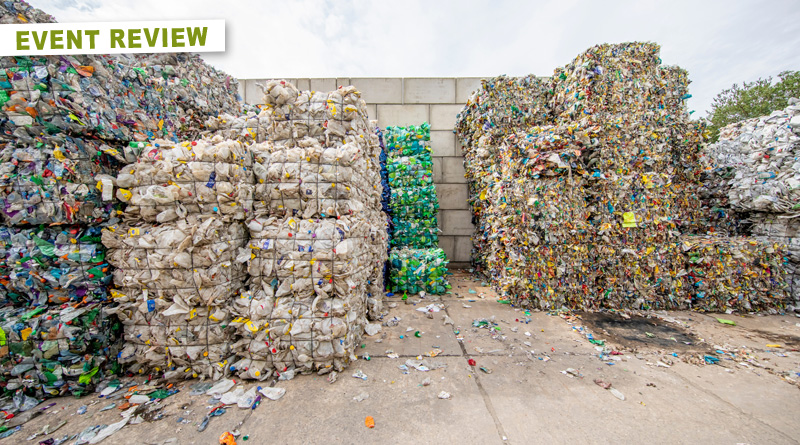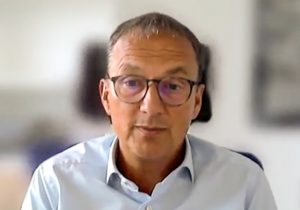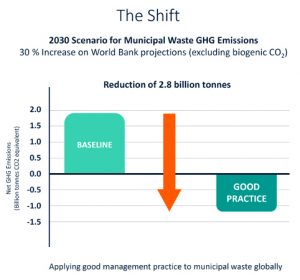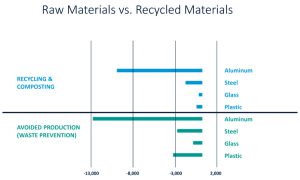European technologies and projects for a global circular economy
Decarbonisation through comprehensive recycling and use of resources
In July, PETplanet accepted two invitations from circular waste management expert and equipment manufacturer Tomra: On July 7, the company hosted a webcast on the topic of CO2 reduction and how climate change can be encouraged by comprehensively optimising waste management and recycling. The company worked with UK sustainability consultancy Eunomia and their experiences and findings are now available online. Speakers for the event were Tomra’s Executive Vice President Dr Volker Rehrmann and Eunomia’s Director of Circular Economy Policy Strategy & Operations, Joe Papineschi. On July 8, Tomra and Borealis invited us into their pilot plant in Lahnstein, Germany, where extensive renovation and expansion measures have now enabled the sorting and recycling of an incredible range of plastics.
Tomra’s “Holistic Resource Systems” webcast essentially examined the levers that must be pulled to decrease CO2 emissions and went on to examine to what extent improvements in recycling systems can contribute to this. Tomra had commissioned Eunomia to carry out a study to examine the effects that a combined waste management system would have on CO2 output and resource optimisation if it were made up of the most ingenious and comprehensive systems currently available in Europe. The focus here was particularly on collecting and processing waste.
Initially, by way of illustration, Eunomia presented some figures on the three main causes of CO2 emissions. Of a global output of 50 billion tonnes of CO2, 51% is due to the energy industry, 23% to the materials sector, i.e. everything that is consumed and that generates CO2 in its manufacturing, and finally 26% to the food system. “We are focusing on the materials sector,” explained Joe Papineschi, “as this is where we see great potential for improvement regarding a lower use of new material, improved and more frequent recycling loops with existing resources and overall, a fundamental lowering of consumption.” The ever-increasing consumption in this sector, resulting from better living conditions and growing purchasing power, also leads to increased energy use and CO2 emissions. According to Eunomia, this would be much lower using recycled material rather than processing virgin material. Mr Papineschi demonstrated this by comparing the aluminium, steel, glass and plastic sectors, where savings of CO2 emissions are significantly better with recycled materials: this, he explained, should dictate how choices are made when the aim is decarbonisation. A further slide showed a scenario for 2030, where the adoption of global installations for the optimised collection and processing of urban waste would lead to a reduction of 2.8 billion tonnes of CO2 annually.
“The technologies to take this step are currently available,” said Joe Papineschi. He went on to outline the essence of the Holistic Resource System, which is a mixture of a deposit system, separate material collection of certain material streams and the collection and sorting of mixed waste as it occurs in household waste. A key consideration would be to strengthen the responsibility of producers in this process.
Following this, Dr Volker Rehrmann gave more detail about the advantages of deposit systems in recycling, especially for PET bottles but also for metal and glass packaging, and discussed a diagram that compared separate collection and a deposit system. “Alongside the aforementioned CO2 impact resulting from avoiding new bottle production, we can simply continue to process the available secondary resources,” stated Dr Rehrmann. “Flagship systems are normally used for beverage containers and these have been operating for many years in all the Scandinavian countries, in Germany and for the last two years in parts of Australia. Implementation is planned in the UK and in many other countries, especially in Europe. High collection rates are achieved because of the value of the packaging, on average around 90% and in Germany up to 95-98%. In terms of emission reduction, the high collection rate is a crucial factor.” According to estimates, 100 new PET bottles could be made into over 200 rPET bottles, thanks to repeated recycling. “For 90 out of 100 collected bottles, we deduct a few losses in the recycling process and achieve a recycling rate of around 75%, which is a conservative estimate; some systems achieve up to 85% or more. However, based on this assumption, 208 recycled bottles could be created from the 100 original new bottles in the specific example.”
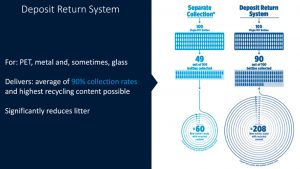
In countries without a deposit system, the return rate lags behind at around 50% and despite the discipline of many people who separate their waste themselves, half the bottles are lost because they have not been collected separately. Using the aforementioned model, this would mean only 60 recycled bottles would be made from 100 new bottles. “In the example of Lithuania, where there is now a deposit system, collection rates for containers were initially only 34%. Just one year after the introduction of the deposit system, it was already 74% and at the end of the second year 92%.”
According to Tomra, a significant loss of potentially recyclable material occurs in mixed waste, e.g. household rubbish. This area has long been considered too complex for sorting and the waste usually ends up in incinerators or landfill. “In Europe, a lot of incineration takes place and a great deal ends up in landfill sites,” says Dr Rehrmann. “However, these landfills should broadly disappear over the coming decades and then everything will be incinerated. But this doesn’t have to happen; we are currently in a position technologically to sort waste and offer alternatives.” A Norwegian study shows that a few European countries can filter out more than twice as much plastic before incineration or landfill dumping by using current technology to sort mixed waste. A pilot project by Tomra with Borealis and Zimmermann Germany offers further evidence, and this recycling demonstration plant achieves a throughput of 10,000 t/a. “Of course, the recycling process requires more effort in terms of sorting and washing because of contamination,” explains Dr Rehrmann. “But very good recycling quality can be achieved for plastics using this method; plastic can be reused so should not be incinerated.”
Dr Rehrmann continued: “From a greenhouse gas perspective, incineration also generates CO2. With separation and the avoidance of new manufacturing going hand in hand, emissions can be reduced significantly.”
Dr Rehrmann also discussed the costs for installing these systems and suggested that in comparison to decarbonising the energy or transport systems, the costs of installing these recycling systems would not be very high.
In the subsequent Q & A session with the audience, the options for recycling food trays were discussed. These are not yet very widespread but according to Dr Rehrmann, Tomra is also working on solutions for tray-2-tray recycling. Tray-2-bottle is also an option; a prototype PET bottle development has just been manufactured from recycled food trays and was shown during the event.
The question was also raised of how influential a circular economy system could be at a European level when this is actually a global problem. Joe Papineschi responded: “The developments and systems can be applied around the world. If a 2.8 billion tonne CO2 reduction is to be achieved, there must be some fundamental rethinking about environmental matters. We are doing a great deal in Europe in terms of technology and policy, and these applications can be adopted with appropriate adjustments. Europe is certainly far from being the template for the world as there is still a great deal of inconsistency here. But with appropriate adaptation for other parts of the world, these things can definitely function and there is an incredible amount of potential. Also, it could be started there immediately, as the whole learning and development process has broadly been completed and already exists here in Europe. The political will to take action is of course also important in other countries. A fundamental re-think as regards sustainability and recycling is necessary but this must also be identified and appropriately regulated.”
Lahnstein pilot plant
At a press briefing on July 8, Borealis and Tomra showcased their pilot plant for advanced mechanical recycling in Lahnstein, Germany. It is capable of sorting post-consumer plastic waste – valuable material that would otherwise be lost to incineration and landfill. This not only keeps feedstock in circulation that are urgently needed by industry to meet its recycling quotas, but also saves CO2 that would otherwise be produced twice – in the manufacture of virgin material and in the incineration, too.
The plant recycles household waste made from both films and rigid plastic, which is delivered as pre-sorted baled product from all over Europe. “In Germany, around two million tonnes of plastic waste that could be mechanically recycled is currently incinerated,” explains Jürgen Priesters, SVP Circular Economy, Head of Business Development Tomra. In Lahnstein, these thermoplastics and polyolefins are reprocessed mechanically.
Furthermore, in contrast to many other recycling facilities, the plant delivers advanced material solutions that are needed for high-quality and sophisticated plastic applications in a wide variety of areas, such as consumer goods or automotive applications. Currently, these are provided in the form of odourless flakes but a further stage of expansion is already in progress, in which completely compounded material can be produced.
The purpose of this demo plant is to manufacture products for brand owners and processors and to test and demonstrate their suitability for sophisticated applications. Successful technical implementation will form the basis for an advanced recycling facility at commercial scale.
Volker Rehrmann, who is also Head of Circular Economy at Tomra, says: “After bringing to life this new department for a circular economy, it is clear that the waste economy and key projects like this one play a huge role in our path to a sustainable future. We are proud to have taken the initiative. The plant is among the most advanced mechanical recycling facilities for post-consumer polymer waste. It is and will be an important prerequisite for further accelerating the switch to a circular economy over the coming years and we are delighted to be part of this pioneering project.”
The plant is operated jointly by Borealis, Tomra and Zimmermann. Borealis is responsible for the economic success of the facility and contributes its specialist skills and extensive knowledge in the fields of innovation, recycling and compounding. Tomra supplies its thorough specialist expertise and comprehensive process and market knowledge, which in turn contribute to the circular economy though the advanced collection and sorting systems. Zimmermann is a waste disposal company with experience in the field of separating various waste types, including plastics, and is responsible for successful plant operation and product quality.

